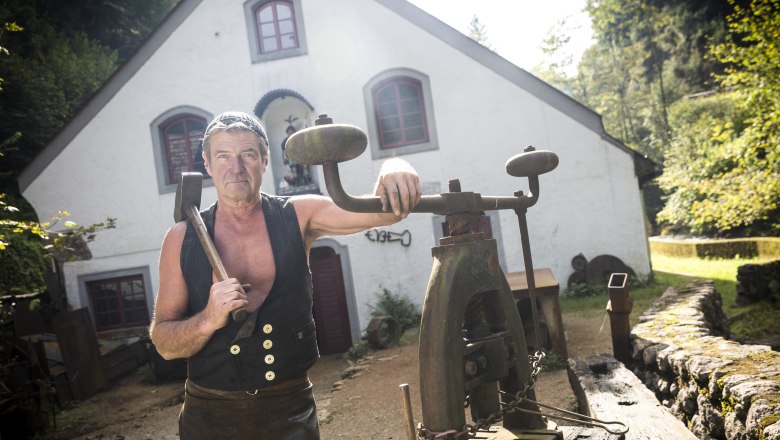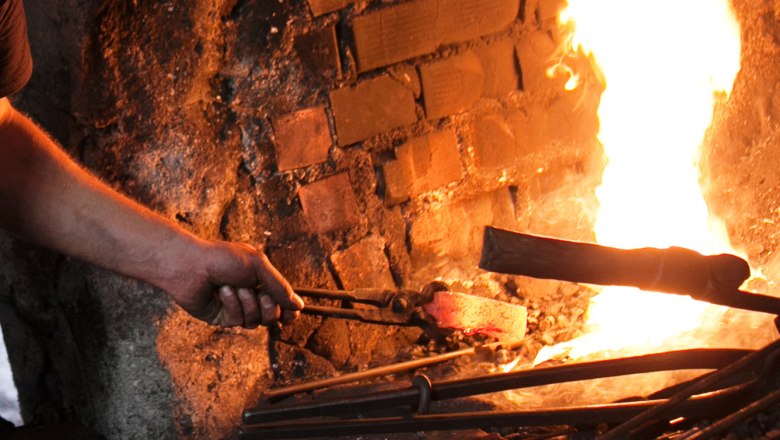Nothing works without the power of the river
Hydropower is essential for blacksmithing. The Eybl hammer mill in Ybbsitz still works according to this belief today.
If you want to explore the natural landscape of the Mostviertel on the Ybbstal cycle path and get a taste of local craftsmanship, it is best to turn south at Ybbsitz and follow the course of the Prollingbach river. After only a few kilometres of driving, you will hear a dull hammering - the sound of the hammer mills. One person who swings the hammer every day is 68-year-old hammer master Sepp Eybl.

"It's over 500 years old", says Sepp Eybl, pointing to an oversized hammer. The massive wooden hammer leans in the middle of the room like a medieval battering ram. "The machine is called a tail hammer", Sepp explains with pride, "the handle is called a helb and the head is called a bear". And under the mighty "bear", it flashes and glows when it strikes the heated metal. Eybl sits calmly in front of it on an old wooden stool and watches the sparks fly. Protective goggles? Eybl doesn’t have any. He is an old-school blacksmith. "I prefer to work with a hand hammer, anvil and my own elbow grease”. With the subtle difference that Eybl does not have to submit to a landlord, as was customary for blacksmiths in the last century. The sturdy blacksmith has been working as a freelance metal artist in Ybbsitz in the Mostviertel for over 25 years. In a forge directly on the banks of the Prollingbach, which has been powering the hammer mills of the Ybbsitzer blacksmith’s mile for half a millennium.


Preservation of historical substance
Even as a child, Sepp Eybl played with a hammer and chisel. His father, a toolmaker, took his son to the workshop from an early age and showed him where the hammer hung. At the Höhere Technische Bundeslehranstalt (Higher Technical College) in Waidhofen, the young Sepp then fully immersed himself in the art of metalworking before passing the master locksmith's examination at the age of 21 and then initially gaining a foothold in plastics production. "But I never really felt comfortable there", says Eybl, who prefers to work with his hands rather than behind a desk. That is why he later bought the old hammer mill in Ybbsitz and lovingly restored it in over three years of work. He paid particular attention to preserving the original substance. After all, the building is a listed building - most of the machines inside are original; the heads of the tail hammers even date back to the 16th century. "Every hammer tells its own story", says hammer master Eybl as he resolutely strikes the glowing piece of metal on the anvil.

Dependent on hydropower
A total of seven hammer machines can be found inside the forge. Two tail hammers, three spring hammers and two air hammers. Different tools are clamped in each hammer head to bring steel into a wide variety of shapes. "The rough stuff happens with the machines, the finishing touches are done by hand", says Eybl, whose remit is varied - from huge sculptures in public spaces to small-format furniture and furnishings, to replicas and restorative commissions. Everything is made in his forge on the Prollingbach, "because nothing works without the power of the river" even if his machines are no longer driven directly by water wheels. Since a small hydroelectric power plant was built in the immediate vicinity of the forge in the 1920s, Eybl's machines have been supplied with energy electrically. It is still the case, however, "that hydropower is indispensable for the blacksmith's trade".

If you want to know exactly how work is done in the time-honoured Eybl hammer mill, it's best to come and see for yourself. "When the hammer door is open, just come in", says Eybl in a hospitable manner. Lately, he is often visited by curious guests in his forge. Not least because the cycle path from Ybbsitz leads directly past the forge. "I even have walk-ins there", laughs Eybl, who is happy to pass on his knowledge of the art of blacksmithing. From the selection of steel and material treatment on an open fire to making simple blades on your own - Eybl offers courses for young and old as well as for inexperienced and professional blacksmiths. "But basically, forging steel is like kneading plasticine", he concludes. And even before you sit in the saddle and pedal back to Ybbsitz, you can already hear Eybl swinging the hammer again. It’s no coincidence that it is also called the "Eyblhammer".


